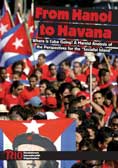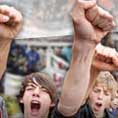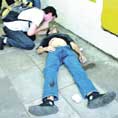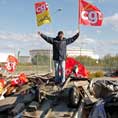



Archive for the Category 'International'

 Report from the second conference of the NAL on October 30-31
Report from the second conference of the NAL on October 30-31
In the summer of 2009, the idea was born for the creation of a united radical left organization in the Czech Republic to break the isolation of the revolutionary forces. After a series of discussions, a conference in November 2009 founded the New Anticapitalist Left (NAL). On the weekend of October 30-31, 2010, after exactly one year of work, a second conference was held. But this NAL conference was attended by only a third as many people as the founding conference one year earlier. This illustrates the bad situation the NAL is in right now. »»»»
 read comments (0)
read comments (0)
 In the mid 1980s, the Cuban leadership introduced a campaign of rectificación and recentralization of the economy. Going against the zeitgeist of Michail Gorbatchov’s Perestroika programm, this might have saved the Cuban system from complete collapse when the Council for Mutual Economic Assistance fell apart and with it a big part of Cuba’s foreign trade[20]. The response to this was the “Special Period in Times of Peace”, which began on July 26, 1990. By 1993, Cuba’s GDP had sunk by 30% – oil imports even by 70%[21]. »»»»
In the mid 1980s, the Cuban leadership introduced a campaign of rectificación and recentralization of the economy. Going against the zeitgeist of Michail Gorbatchov’s Perestroika programm, this might have saved the Cuban system from complete collapse when the Council for Mutual Economic Assistance fell apart and with it a big part of Cuba’s foreign trade[20]. The response to this was the “Special Period in Times of Peace”, which began on July 26, 1990. By 1993, Cuba’s GDP had sunk by 30% – oil imports even by 70%[21]. »»»»

 Cuba’s system fits in with Leon Trotsky’s analysis of a degenerate workers’ state: a society in which the private property of the means of production has been abolished (a precondition for the transition to socialism) but in which a privileged bureaucracy controls all political and economic institutions and suppresses all independent activity by the masses. Therefore, the transition to socialism – the withering away of the state as the working population increasingly takes over all tasks of administration – is blocked. And as a result, the whole system tends to slide back to capitalism. »»»»
Cuba’s system fits in with Leon Trotsky’s analysis of a degenerate workers’ state: a society in which the private property of the means of production has been abolished (a precondition for the transition to socialism) but in which a privileged bureaucracy controls all political and economic institutions and suppresses all independent activity by the masses. Therefore, the transition to socialism – the withering away of the state as the working population increasingly takes over all tasks of administration – is blocked. And as a result, the whole system tends to slide back to capitalism. »»»»

 Cuba has never been a socialist society in which the working class manages the means of production democratically. Cuba has never seen any kid of proletarian democracy: no kind of workers’ and peasants’ councils with elected and recallable delegates, similar to the Soviet system established by the October Revolution in Russia and subsequently crushed by the Stalinist counterrevolution of the 1920s/30s. The Cuban bureaucracy had no need to carry out a political counterrevolution to crush organs of proletarian democracy because such organs simply did not exist: from the beginning it based itself on the Bonapartist state apparatus established before the expropriation of the bourgeoisie. “Castro, who in 1959 was a bonaparte for the enfeebled Cuban bourgeoisie was, by 1962, a bonaparte “for” the politically expropriated Cuban working class.”[12] »»»»
Cuba has never been a socialist society in which the working class manages the means of production democratically. Cuba has never seen any kid of proletarian democracy: no kind of workers’ and peasants’ councils with elected and recallable delegates, similar to the Soviet system established by the October Revolution in Russia and subsequently crushed by the Stalinist counterrevolution of the 1920s/30s. The Cuban bureaucracy had no need to carry out a political counterrevolution to crush organs of proletarian democracy because such organs simply did not exist: from the beginning it based itself on the Bonapartist state apparatus established before the expropriation of the bourgeoisie. “Castro, who in 1959 was a bonaparte for the enfeebled Cuban bourgeoisie was, by 1962, a bonaparte “for” the politically expropriated Cuban working class.”[12] »»»»

 The Cuban Revolution began in 1917 with the October Revolution in Russia. During the first imperialist World War, the Russian working class, together with the poor peasantry, did not only overthrow the Czarist monarchy but also broke the power of the propertied classes. Led by the revolutionary workers’ party known as the Bolsheviks, the workers’ and peasants’ councils carried out a land reform without any compensation to the former owners and nationalized the industry under workers’ control. »»»»
The Cuban Revolution began in 1917 with the October Revolution in Russia. During the first imperialist World War, the Russian working class, together with the poor peasantry, did not only overthrow the Czarist monarchy but also broke the power of the propertied classes. Led by the revolutionary workers’ party known as the Bolsheviks, the workers’ and peasants’ councils carried out a land reform without any compensation to the former owners and nationalized the industry under workers’ control. »»»»

 The current struggle of the French workers and youth represents an obvious leap compared to the previous cycle of the class struggle that began in 1995. It is announcing a higher level of class struggle, more open, more radicalized and more classical, that is, with greater centrality of the working class and with a protagonist role of students workers and in the factories. It is a new cycle of the class struggle in response to the world crisis underway with repercussions in France and internationally. The economic depression leaves the bourgeoisie with only one possible course of action: attacking the social conquests that still remain from the so-called welfare state and worsening the living conditions of the masses, including groups that in their time benefited from the crumbs of the neo-liberal offensive, such as some people from the middle class. »»»»
The current struggle of the French workers and youth represents an obvious leap compared to the previous cycle of the class struggle that began in 1995. It is announcing a higher level of class struggle, more open, more radicalized and more classical, that is, with greater centrality of the working class and with a protagonist role of students workers and in the factories. It is a new cycle of the class struggle in response to the world crisis underway with repercussions in France and internationally. The economic depression leaves the bourgeoisie with only one possible course of action: attacking the social conquests that still remain from the so-called welfare state and worsening the living conditions of the masses, including groups that in their time benefited from the crumbs of the neo-liberal offensive, such as some people from the middle class. »»»»

 When the guerilla assumed power, its program was based on the utopian vision of an independent Cuban capitalism, including a land reform to give land to poor peasants and decrease US influence in agriculture. Castro famously declared that the revolution was “not red but olive green” and in a visit to the United States in April 1959, he went even further: “I have said clearly and definitively that we are not communists. The doors are open to private investments that contribute to the development of industry in Cuba. It is absolutely impossible for us to make progress if we don’t reach an understanding with the USA.”[7] »»»»
When the guerilla assumed power, its program was based on the utopian vision of an independent Cuban capitalism, including a land reform to give land to poor peasants and decrease US influence in agriculture. Castro famously declared that the revolution was “not red but olive green” and in a visit to the United States in April 1959, he went even further: “I have said clearly and definitively that we are not communists. The doors are open to private investments that contribute to the development of industry in Cuba. It is absolutely impossible for us to make progress if we don’t reach an understanding with the USA.”[7] »»»»

 Cuba was historically dominated by imperialism, first as a colony of Spain and then as a semi-colony of the United States. The island gained independence in 1902, but the Cuban constitution included an amendment granting the United States the right to intervene militarily at any time until 1934. The political power of US imperialism had an economic foundation, since US companies owned a large part of Cuba’s land and industry. For example, US capital owned 35% of sugar production, alongside countless hotels and casinos, while the rest of the economy belonged to a small and slavishly pro-imperialist Cuban bourgeoisie[4]. »»»»
Cuba was historically dominated by imperialism, first as a colony of Spain and then as a semi-colony of the United States. The island gained independence in 1902, but the Cuban constitution included an amendment granting the United States the right to intervene militarily at any time until 1934. The political power of US imperialism had an economic foundation, since US companies owned a large part of Cuba’s land and industry. For example, US capital owned 35% of sugar production, alongside countless hotels and casinos, while the rest of the economy belonged to a small and slavishly pro-imperialist Cuban bourgeoisie[4]. »»»»

 Cuba seems like an anachronism in today’s world. Other formerly “socialist” states reintroduced capitalism in the upheavals of the 1990s. In Russia, the Communist Party was toppled and its system collapsed. In China and Vietnam, the Communist Parties themselves led a controlled process of reforms to reestablish a market economy. Cuba alone has maintained to this day an economy which is dominated not by the laws of the market but by a plan[1]. »»»»
Cuba seems like an anachronism in today’s world. Other formerly “socialist” states reintroduced capitalism in the upheavals of the 1990s. In Russia, the Communist Party was toppled and its system collapsed. In China and Vietnam, the Communist Parties themselves led a controlled process of reforms to reestablish a market economy. Cuba alone has maintained to this day an economy which is dominated not by the laws of the market but by a plan[1]. »»»»

 Buenos Aires ++ Violent clashes between strike activists and the trade union bureaucracy ++ 23-year-old activist murdered by thugs hired by the trade union bureaucracy ++
Buenos Aires ++ Violent clashes between strike activists and the trade union bureaucracy ++ 23-year-old activist murdered by thugs hired by the trade union bureaucracy ++
The conflict over the reincorporation of fired and subcontracted workers on the Roca train line in southern Buenos Aires, which has been going on for more than eight months, gained a shocking new quality yesterday. During a protest in the neighborhoods of Avellaneda and Barracas, in which precarious train workers participated alongside militants of different left-wing groups, violent clashes erupted between the protesters and a group of thugs hired by the Unión Ferroviaria (Railroad Union, UF) to prevent the protests. While only rocks were used at the beginning, later at least two of the provocateurs hired by the UF bureaucracy under José Pedraza pulled out guns and shot at the protesters. The 23-year-old student Mariano Ferreyra, militant of the Partido Obrero (PO, “Workers’ Party”), was shot dead and three more protesters were gravely injured; a 56-year-old militant (also PO) is still in mortal danger. »»»»

 Tendencies towards radicalization threatened by the treacherous leaderships of the trade unions
Tendencies towards radicalization threatened by the treacherous leaderships of the trade unions
Following three days of protests against the pension reform since the end of the summer (September 7 and 23, and October 2), the government was betting on an ebbing of the demonstrations, especially considering that the Senate hurriedly voted on the main articles of the law, enabling Sarkozy to send a clear message to the public: “everything has been decided, there’s no need to demonstrate, the law has been passed.” Nonetheless, the day of strikes and demonstrations on October 12 in France was historic. »»»»
